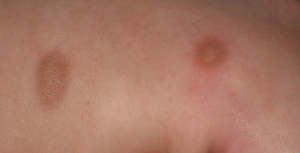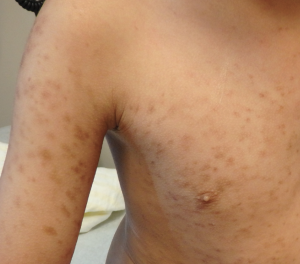Chapter 8: Lumps and Bumps
Mastocytosis
Solitary Mastocytomas
Solitary Mastocytomas are common in childhood. They present as pink to tan colored plaques with a peau-d’orange surface. They represent a collection of mast cells in the skin that will release histamine when triggered. They often develop surrounding erythema and an urticarial wheal, or even blister, with mechanical irritation (Darier sign). Mastocytomas usually resolve spontaneously over several years.

Urticaria Pigmentosa
Urticaria Pigmentosa is another form of mastocytosis in childhood, which presents with multiple (sometimes hundreds) of pink to red-brown macules and papules. They tend to spare the palms and soles. Urticaria pigmentosa tends to develop in the first few years of life, but generally the lesions will spontaneously resolve by or during adolescence. Due to the increased number of mast cells in the skin, children with urticaria pigmentosa may develop systemic symptoms of histamine release, including pruritus, flushing and GI upset. It is important to avoid triggers of mast cell degranulation such as aspirin, NSAIDs, morphine and alcohol. In addition, exercise, heat and emotional stress can also be a trigger in some patients. Routine therapy with antihistamines and/or epipen might be recommended.


